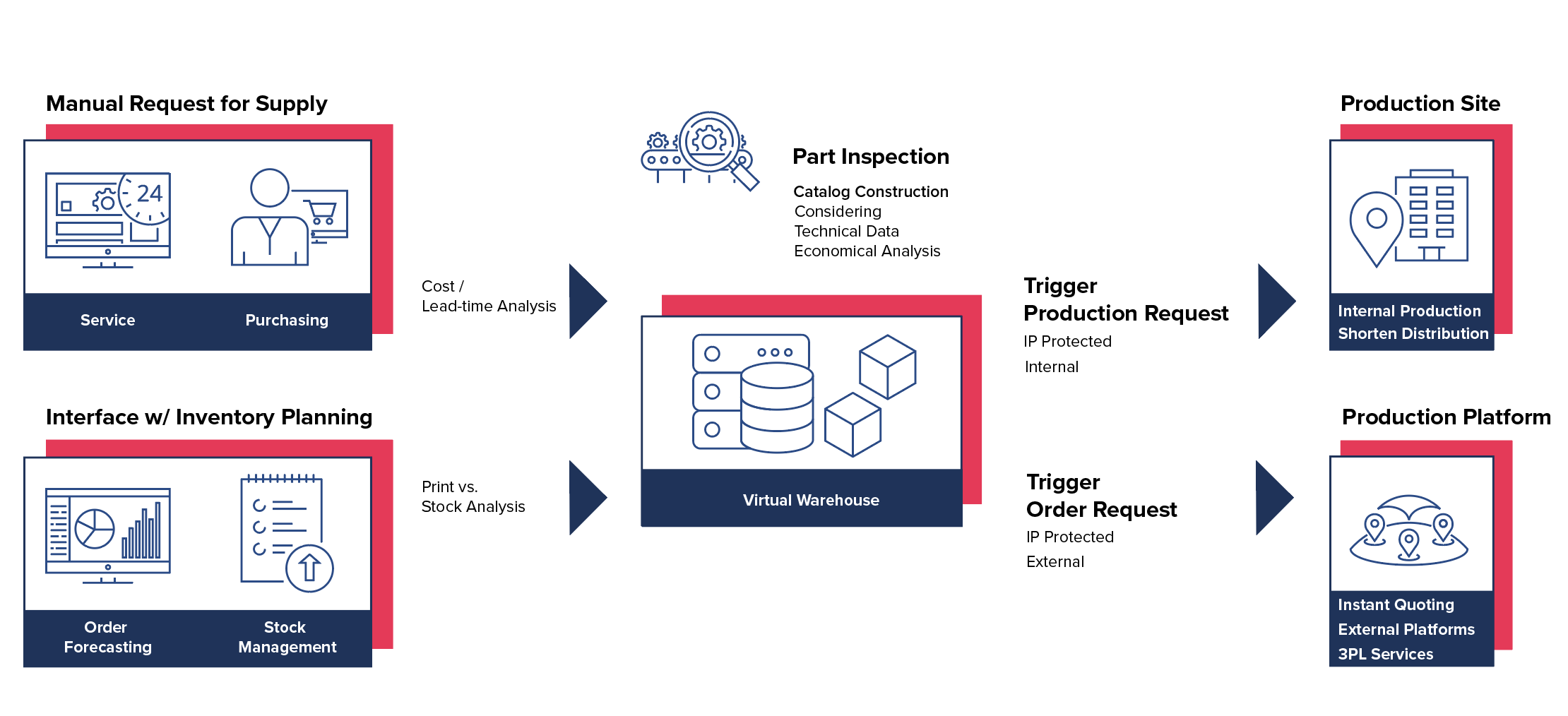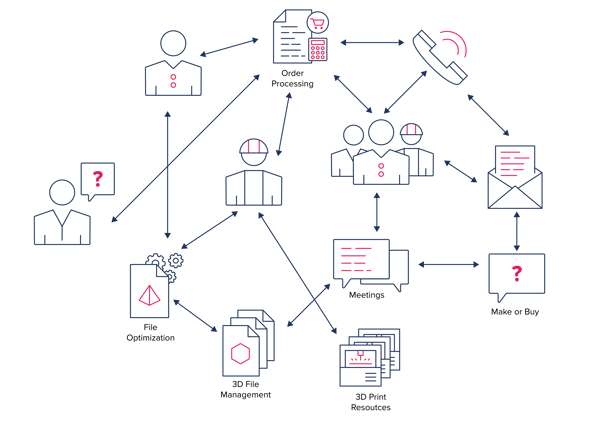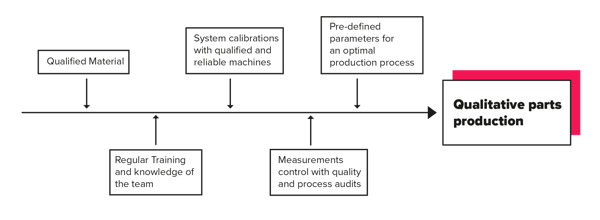5 Keys to Success in a Distributed Manufacturing Model
Find out how to leverage additive manufacturing to support distributed manufacturing efforts and create more flexible supply chains.
Yesterday’s version of manufacturing is predominantly based on identifying cheap ways to produce parts overseas. A local manufacturer may spend months or years developing a trustworthy relationship with a production partner on a different continent to leverage cheap labor to produce parts with higher margins.
However, recent lessons from the COVID-19 pandemic have renewed interest in localized manufacturing. Pinched supply chains, labor, and product shortages have all revealed opportunities to flip the script on traditional manufacturing practices.
Simply put, the global supply chain is cumbersome and outdated.
Distributed Manufacturing is the Future
Distributed manufacturing is the future and the advantages are seemingly endless. The novel coronavirus exploits weaknesses of the supply chain and why companies are transitioning to a distributed, or local manufacturing approach. Distributed manufacturing is the process of using global and remote expertise, diversifying the supplier network, and producing parts locally. 3D printing (AM) is the key component that enables a local engineering team to print on-demand and eliminate unnecessary inventory. The key benefits of distributed manufacturing are as follows:
- Localization
Producing locally removes expensive transportation costs, taxes, and tariffs. In addition, manufacturers are realizing that it makes financial and moral sense to the local community by adopting the distributed manufacturing method—68% of every dollar spent with a local retailer goes back into the community vs. 48% spent with larger or corporate retailers. - Leverage Expertise
The globalization of intellectual talent has proven to be a significant advantage for small, medium, and large enterprises. Distributed manufacturing removes various limitations and further improves a company’s ability to leverage a larger and remote network of talent and expertise. Through supply chain diversification, a manufacturer can distribute workloads and reduce the risk of failure. - Sustainability
Sustainability in this scenario references company longevity and environmental stewardship. Adopting the agile manufacturing concept enables a company to limit the number of permanent facilities which, in turn, saves on capital expenditures or risky investments. In addition, the distributed manufacturing model relies on local productivity, which eliminates the need for transportation—thus reducing emissions and negative environmental impacts.
Additive manufacturing is disrupting the way we design and manufacture while forcing us to consider alternatives to the traditional supply chain structure. Why stock unnecessary replacement parts in an expensive warehouse on a different continent? Why spend months and years developing relationships with overseas production facilities that will become outdated in the near future?
Distributed manufacturing is the answer to these questions and more. When your team decides to adopt this methodology, what challenges will you face? The 3YOURMIND team of experts presents the 5 Keys to Success in a Distributed Manufacturing Model.

1. Improve Supplier Transparency through Streamlined Communication
- Challenge: We’ve all been there. Compartmentalized teams, departments operating in silos, and dotted lines of management. The complexity of every organization leads to lackluster internal communications and various departments measure success differently. The distributed manufacturing model requires coordination amongst several facilities typically operating in different time zones. Although this is common amongst all manufacturing facilities entering the next generation of industrialization, streamlined communication, and role identification is a specific challenge for each organization.

- Solution: Improving traceability, reporting, and measurement requires an integrated communication tool. Similar to Salesforce Chatter or Microsoft Teams, these tools were built to improve communications which lead to better-defined roles and group productivity. Streamlining communication must never be overlooked.
2. Eliminate Security Threats and Protect Intellectual Property
- Challenge: Referred to as the oil of the 21st century, intellectual property is typically the most valuable asset a company can own. Protecting IP and ensuring file security is of utmost importance and must be considered when adopting the distributed manufacturing model. What if the file is interrupted or modified somewhere throughout the process? What if the wrong file is sent for print and shipment?
- Solution: Security will require a fluid and evolving approach but there are some immediate solutions. Integrating traceability software with versioning and custom user access are valuable tactics that exist today. As the industry progresses, an interesting alternative with the use of blockchain technology could become a viable option. Currently, in experimentation, the encryption capabilities of blockchain are attractive to many companies that wish to improve 3D file security and intellectual property.
3. Embrace Complexity and Ensure Repeatable Results Across Multiple Facilities

- Challenge: This graphic represents the complexity of producing identical parts in separate facilities, across the globe and with different standards and regulatory requirements. It takes one weak link in the chain to disrupt the entire process. The distributed manufacturing methodology relies on a seamless system of qualified materials, system calibrations, pre-defined parameters, and constant training to the engineering staff. Creating a consistent process is already a challenge, so what does that say about the roll-out to facilities across the globe?
- Solution: Numbers never lie, and data is the lifeblood of every manufacturing facility. Integrating a tool that eliminates confusion and operates purely on data transparency allows for actionable and measurable processes to thrive. Human error will always exist and garbage data input will lead to less than favorable output. Remove the thinking and let the numbers speak for themselves.
4. Empower Your Leaders
Challenge: Those who do not learn from their history are doomed to repeat it. This famous quote references the value of learning from one’s mistakes and taking a proactive stance to eliminate future problems and concerns. Although distributed manufacturing is a likely candidate to solve many supply chain problems in the near future, it’s still a developing concept. Additionally, specific solutions will be required for individual companies, and customization is inevitable. The question isn’t whether or not distributed manufacturing will be a viable solution—the question is who will your company assign to manage it? This inevitable shift in manufacturing will include every department of your organization. From product development to manufacturing, from operations to legal council, this requires a coordinated effort.
- Solution: Regardless of who becomes responsible for managing your company’s leap into the next generation of industrialization, one thing is certain: they will need an integrated tool that can measure performance and workflow efficiency. Communication software that can monitor volume production orders from multiple service locations and track material utilization. Data aggregation, transparent process management, and streamlined communication will be the most valuable components to a successful distributed manufacturing network.
5. Simplify IT Infrastructure
- Challenge: Similar to streamlining communication and identifying roles, the IT infrastructure poses another unique challenge across multiple facilities. It’s not uncommon for different sites within your organization to operate with disparate technology platforms. Congregating data, sharing of assets and basic functionality rely on an integrated IT infrastructure. How does your company share assets and information?
- Solution: The value of integrating a streamlined communication tool across multiple facilities and departments can save management teams time, money, and headaches. In addition, employees often use unauthorized third-party file-sharing tools to transfer information due to poor IT infrastructures, which may lead to a security breach.
